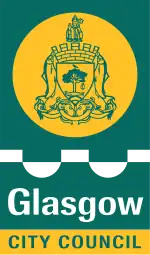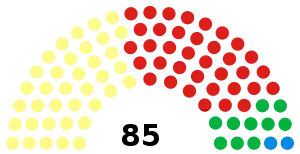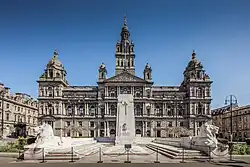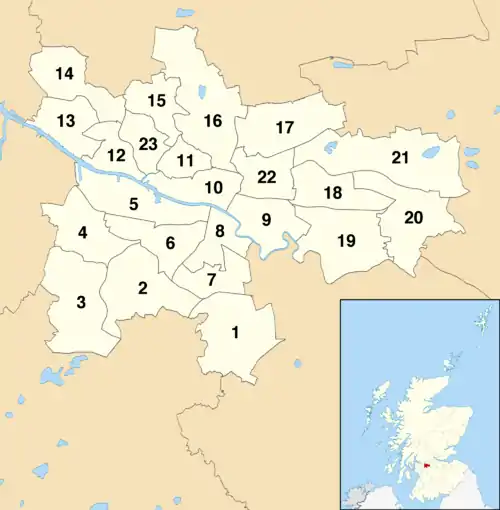Glasgow City Council
Glasgow City Council (Scottish Gaelic: Comhairle Baile Ghlaschu) is the local government authority for Glasgow City council area, Scotland. In its modern form it was created in 1996. Glasgow was formerly governed by a corporation, also known as the town council, from the granting of its first burgh charter in the 1170s until 1975. From 1975 until 1996 the city was governed by City of Glasgow District Council, a lower-tier authority within the Strathclyde region.
Glasgow City Council Comhairle Baile Ghlaschu | |
|---|---|
| Full council election every 5 years | |
 | |
 Glasgow City Council logo | |
| Type | |
| Type | |
| History | |
| Founded | 1 April 1996 |
| Preceded by | Glasgow Corporation (c. 1175–1975) City of Glasgow District Council (1975–1996) |
| Leadership | |
Annemarie O'Donnell since December 2014[3] | |
| Structure | |
| Seats | 85 |
 | |
Political groups |
|
| Elections | |
| Single transferable vote | |
Last election | 5 May 2022 |
Next election | 6 May 2027 |
| Motto | |
| Let Glasgow Flourish | |
| Meeting place | |
 | |
| City Chambers, George Square, Glasgow, G2 1DU | |
| Website | |
| www | |
Glasgow City Council has been under no overall control since 2017, being led by a Scottish National Party minority administration. The council has its headquarters at Glasgow City Chambers in George Square, completed in 1889.
History
Glasgow Corporation
Glasgow was given its first burgh charter sometime between 1175 and 1178 by William the Lion.[4] It was then run by "Glasgow Town Council", also known as "Glasgow Corporation", until 1975. The city was part of Lanarkshire until 1893, but the functions which operated at county level were relatively few, largely being limited to lieutenancy and sheriffdom. When elected county councils were created in 1890 under the Local Government (Scotland) Act 1889, Glasgow Corporation was deemed capable of running its own affairs and so the city was excluded from the area controlled by Lanarkshire County Council, although the county council nevertheless chose to meet in Glasgow as a conveniently accessible location.[5][6] In 1893, Glasgow became its own county for lieutenancy and sheriffdom purposes too, being made a county of itself.[7]
The boundaries of the burgh were extended several times to incorporate areas where the urban zone outgrew the previous boundaries or where there were plans for development. These significant expansions comprise:
- 1830 - Blythswood[8]
- 1846 - Anderston, Calton, and Gorbals[9]
- 1891 - Crosshill, Govanhill, Pollokshields, Pollokshields East, Hillhead, and Maryhill[10]
- 1905 - Kinning Park[11]
- 1912 - Govan, Partick, and Pollokshaws[12]
- 1926 - Cardonald, Crookston, Lambhill, Mansewood, Millerston, Nitshill, Scotstounhill, and Yoker[13]
- 1938 - Castlemilk, Darnley, Drumchapel, and Easterhouse[14]
City of Glasgow District Council
Local government across Scotland was reorganised in 1975 under the Local Government (Scotland) Act 1973, which replaced the counties and burghs with a two-tier structure of upper-tier regions and lower-tier districts. Glasgow became a district within the Strathclyde region. The local authority was therefore renamed the "City of Glasgow District Council". The Glasgow district covered a larger area than the pre-1975 city, gaining Baillieston, Cambuslang, Carmunnock, Carmyle, Garrowhill, Mount Vernon, Rutherglen, and Springboig.[15][16][17]
Glasgow City Council
Local government was reorganised again in 1996 under the Local Government etc. (Scotland) Act 1994, which abolished the regions and districts created in 1975 and established 32 single-tier council areas across Scotland, one being the city of Glasgow. The council adopted its modern name of "Glasgow City Council" following these reforms. The council area created in 1996 was smaller than the district which had existed between 1975 and 1996, with the Rutherglen and Cambuslang area being transferred instead to the new South Lanarkshire council area following a local referendum.[18][19]
Political control
For political control before 1975 see Politics of Glasgow
The first election to the City of Glasgow District Council was held in 1974, initially operating as a shadow authority alongside the outgoing corporation until the new system came into force on 16 May 1975. A shadow authority was again elected in 1995 ahead of the reforms which came into force on 1 April 1996. Political control of the council since 1975 has been as follows:[20]
City of Glasgow District Council
| Party in control | Years | |
|---|---|---|
| Labour | 1975–1977 | |
| No overall control | 1977–1980 | |
| Labour | 1980–1996 | |
Glasgow City Council
| Party in control | Years | |
|---|---|---|
| Labour | 1996–2017 | |
| No overall control | 2017– | |
Leadership
For leaders before 1996 see Politics of Glasgow
The council is ceremonially headed by the Lord Provost of Glasgow, who convenes meetings of the council and performs associated tasks as a general civic leader. The role dates from the 15th century. Since 1893, when the city was made a county of itself, the Lord Provost has also acted as Lord Lieutenant of the city. The current Lord Provost, elected in May 2022 after that month's election, is Jacqueline McLaren.
Political leadership is provided by the leader of the council. The council changed from an executive-led governance system to a committee-led system in September 2017, with the leader of the council since then chairing the City Administration Committee.[21] The leaders since 1996 have been:[22]
| Councillor | Party | From | To | |
|---|---|---|---|---|
| Bob Gould | Labour | 1 Apr 1996 | 23 Oct 1997 | |
| Frank McAveety | Labour | 23 Oct 1997 | 6 May 1999 | |
| Charlie Gordon | Labour | 20 May 1999 | 24 May 2005 | |
| Steven Purcell[23] | Labour | 24 May 2005 | 2 Mar 2010 | |
| Gordon Matheson | Labour | 13 May 2010 | 10 Sep 2015 | |
| Frank McAveety | Labour | 10 Sep 2015 | May 2017 | |
| Susan Aitken | SNP | 18 May 2017 | ||
Composition
Following the 2022 election:
| Party | 2022 result | |
|---|---|---|
| Scottish National Party | 37 | |
| Scottish Labour | 36 | |
| Scottish Green[lower-alpha 1] | 10 | |
| Scottish Conservative | 2 |
- The Scottish Greens are in a working agreement with the Glasgow City Council administration, but they do not form part of it.
Elections
The council consists of 85 councillors elected for a five-year term from 23 wards. Since 2007 elections have been held every five years under the single transferable vote system, introduced by the Local Governance (Scotland) Act 2004 to replace the first-past-the-post system.
The most recent full council election took place on 5 May 2022, in which no party held a majority of the seats, as had also been the case in the preceding 2017 election. The Scottish National Party remained the largest party, winning 37 seats, whilst Labour won 36 seats, an increase relative to its 2017 result. The Greens won ten seats, also improving on their position in 2017, whilst the Conservatives lost all but two councillors.
The next election is due to take place on 6 May 2027. Election results since 1995 have been as follows:[20]
| Year | Seats | SNP | Labour | Green | Conservative | Liberal Democrats | Independent / Other | Notes |
|---|---|---|---|---|---|---|---|---|
| 1995 | 83 | 1 | 77 | 0 | 3 | 1 | 1[lower-alpha 1] | Labour majority[24] |
| 1999 | 79 | 2 | 74 | 0 | 1 | 1 | 1[lower-alpha 2] | New ward boundaries.[25] Labour majority[26] |
| 2003 | 79 | 3 | 71 | 0 | 1 | 3 | 1[lower-alpha 2] | Labour majority[27] |
| 2007 | 79 | 22 | 45 | 5 | 1 | 5 | 1[lower-alpha 3] | New ward boundaries.[28] Labour majority[29] |
| 2012 | 79 | 27 | 44 | 5 | 1 | 1 | 1[lower-alpha 4] | Labour majority[30] |
| 2017 | 85 | 39 | 31 | 7 | 8 | 0 | 0 | New ward boundaries.[31] SNP minority[32] |
| 2022 | 85 | 37 | 36 | 10 | 2 | 0 | 0 | SNP minority |
Premises
The council has its meeting place and main offices at Glasgow City Chambers in George Square.[33]
Glasgow Corporation was based at the Tolbooth at Glasgow Cross from at least the fifteenth century, which was rebuilt several times. The last Tolbooth on the site was built in 1626. Most of that building was demolished in 1921, leaving only the steeple standing as a clock tower.[34][35]
.jpg.webp)
In 1814 the corporation vacated the Tolbooth and moved to the new Justiciary Buildings on Saltmarket, overlooking Glasgow Green. The building served both as council chamber and offices for the corporation and as the courthouse for the Lower Ward of Lanarkshire.[36] In 1844 the corporation and sheriff court moved to the new Sheriff Court on Wilson Street. The Justiciary Buildings on Saltmarket thereafter served solely as a courthouse.
In 1889 the council moved to its own purpose-built headquarters at the City Chambers in George Square.[37]
Wards

The current multi-member ward system (23 wards, 85 seats) was introduced for the 2017 council election, replacing a similar model (21 wards, 79 seats) in place between 2007 and 2017:
| Ward number | Ward | Seats | Population (2015)[38] |
|---|---|---|---|
| 1 | Linn[lower-alpha 1] | 4 | 29,575 |
| 2 | Newlands/Auldburn[lower-alpha 2] | 3 | 23,144 |
| 3 | Greater Pollok[lower-alpha 3] | 4 | 30,729 |
| 4 | Cardonald[lower-alpha 4] | 4 | 29,639 |
| 5 | Govan[lower-alpha 5] | 4 | 26,769 |
| 6 | Pollokshields[lower-alpha 6] | 4 | 27,983 |
| 7 | Langside[lower-alpha 7] | 4 | 29,060 |
| 8 | Southside Central[lower-alpha 8] | 4 | 25,266 |
| 9 | Calton[lower-alpha 9] | 4 | 27,460 |
| 10 | Anderston/City/Yorkhill[lower-alpha 10] | 4 | 30,184 |
| 11 | Hillhead[lower-alpha 11] | 3 | 25,411 |
| 12 | Victoria Park[lower-alpha 12] | 3 | 20,950 |
| 13 | Garscadden/Scotstounhill[lower-alpha 13] | 4 | 30,565 |
| 14 | Drumchapel/Anniesland[lower-alpha 14] | 4 | 29,432 |
| 15 | Maryhill[lower-alpha 15] | 3 | 22,244 |
| 16 | Canal[lower-alpha 16] | 4 | 25,000 |
| 17 | Springburn/Robroyston[lower-alpha 17] | 4 | 27,237 |
| 18 | East Centre[lower-alpha 18] | 4 | 27,991 |
| 19 | Shettleston[lower-alpha 19] | 4 | 25,806 |
| 20 | Baillieston[lower-alpha 20] | 3 | 21,663 |
| 21 | North East[lower-alpha 21] | 3 | 20,457 |
| 22 | Dennistoun[lower-alpha 22] | 3 | 20,861 |
| 23 | Partick East/Kelvindale[lower-alpha 23] | 4 | 28,914 |
Ward notes
- Carmunnock, Castlemilk, Cathcart (part), Croftfoot, King's Park (part), Muirend, Simshill
- Arden, Auldhouse, Carnwadric, Cowglen, Eastwood, Hillpark, Kennishead, Mansewood, Merrylee, Newlands, Pollokshaws
- Crookston (part), Darnley, Deaconsbank, Hurlet, Nitshill, Parkhouse, Pollok (part), Priesthill, Southpark
- Cardonald, Corkerhill, Crookston (part), Hillington, Mosspark, Penilee, Pollok (part)
- Cessnock, Drumoyne, Govan, Ibrox, Kinning Park, Shieldhall, Tradeston
- Bellahouston, Craigton, Dumbreck, Pollokshields, Port Eglinton, Shawlands (part), Strathbungo
- Battlefield, Cathcart (part), Langside, King's Park (part), Mount Florida, Shawlands (part), Toryglen
- Crosshill, Gorbals, Queen's Park, Govanhill, Hutchesontown, Oatlands
- Barrowfield, Bridgeton, Calton, Dalmarnock, Gallowgate, Newbank, Parkhead (part)
- Anderston, Charing Cross, Cowcaddens, Finnieston, Garnethill, Glasgow City Centre, Kelvingrove, Kelvinhaugh, Merchant City, Townhead, Yorkhill
- Hillhead, Kelvinbridge, North Kelvinside, Park District, St George's Cross, Woodlands, Woodside
- Anniesland (part), Broomhill, Glasgow Harbour, Jordanhill, Thornwood, Whiteinch
- Garscadden, Knightswood (part), Scotstounhill, Scotstoun, Yoker
- Anniesland (part), Blairdardie, Drumchapel, Knightswood (part), Old Drumchapel, Temple
- Gilshochill, Maryhill, Summerston, Wyndford
- Cadder, Colston, Hamiltonhill, Milton, Lambhill, Parkhouse, Port Dundas, Possilpark, Ruchill
- Balornock, Barmulloch, Millerston (part), Robroyston, Springburn
- Barlanark, Cranhill, Carntyne, Greenfield Riddrie, Springboig
- Braidfauld, Carmyle, Lilybank, Mount Vernon, Parkhead (part), Sandyhills, Shettleston, Tollcross
- Baillieston, Broomhouse, Easthall, Garrowhill, Swinton, Wellhouse
- Blackhill, Craigend, Easterhouse, Garthamlock, Hogganfield, Ruchazie
- Dennistoun, Germiston, Haghill, Royston, Sighthill
- Dowanhill, Hyndland, Kelvindale, Kelvinside, Partick (part)
Footnotes
- "Council minutes, 19 May 2022". Glasgow City Council. Retrieved 29 January 2023.
- "SNP will run Glasgow Council as minority". 18 May 2017 – via www.bbc.co.uk.
- Shannon, Kate (12 November 2014). "New chief executive for Glasgow City Council". Holyrood. Retrieved 29 January 2023.
- Marwick, J. D. (1897). Charters and Documents relating to the City of Glasgow 1175–1649. British History Online. pp. v–xxiii. Retrieved 27 January 2023.
- Guide to local government in parishes, counties and burghs. Edinburgh: Royal College of Physicians. 1892. pp. xxiii–xxx. Retrieved 31 December 2022.
- "Preparing for the elections in Scotland". The County Council Magazine. London: F. Warne and Company. 1890. p. 284. Retrieved 31 December 2021.
- "County of the City of Glasgow Act 1893 (c. 188)". legislation.gov.uk. The National Archives. Retrieved 5 February 2023.
- "Glasgow Magistrates and Police Act 1830 (c. 42)". legislation.gov.uk. The National Archives. Retrieved 5 February 2023.
- Glasgow Municipal, Police, and Statute Labour Act, 1846. 1846. Retrieved 29 January 2023.
- "City of Glasgow Act 1891 (c. 130)". legislation.gov.uk. The National Archives. Retrieved 5 February 2023.
- "Glasgow Corporation Order Confirmation Act 1905 (c. 127)". legislation.gov.uk. The National Archives. Retrieved 5 February 2023.
- "Glasgow Boundaries Act 1912 (c. 95)". legislation.gov.uk. The National Archives. Retrieved 5 February 2023.
- "Glasgow Boundaries Act 1925 (c. 131)". legislation.gov.uk. The National Archives. Retrieved 5 February 2023.
- "Glasgow Boundaries Order Confirmation Act 1937 (c. 6)". legislation.gov.uk. The National Archives. Retrieved 5 February 2023.
- "Local Government (Scotland) Act 1973", legislation.gov.uk, The National Archives, 1973 c. 65, retrieved 29 January 2023
- Irene Maver. "Modern Times: 1950s to The Present Day > Neighbourhoods". The Glasgow Story. Retrieved 4 November 2018.
- "Scotland's Landscape: City of Glasgow". BBC. Retrieved 4 November 2018.
- "Local Government etc. (Scotland) Act 1994", legislation.gov.uk, The National Archives, 1994 c. 39, retrieved 29 January 2023
- "Priority is finding a way forward for Glasgow". The Herald. 4 September 2001. Retrieved 29 January 2023.
- "Compositions calculator". The Elections Centre. Retrieved 29 January 2023.
- "Glasgow City Council: Review of Decision-Making Arrangements, 14th Sept 2017".
- "Council minutes". Glasgow City Council. Retrieved 29 January 2023.
- "Steven Purcell resigns as councillor after quitting as Glasgow City Council leader". Daily Record. 5 March 2010. Retrieved 29 January 2023.
- Scottish Council Elections 1995 - Results and Statistics, H.M. Bochel, D.T. Denver, p.95-97
- "The Glasgow City (Electoral Arrangements) Order 1998", legislation.gov.uk, The National Archives, SI 1998/3078, retrieved 29 January 2023
- Scottish Council Elections 1999 - Results and Statistics, H.M. Bochel, D.T. Denver
- Chapter 57 Clyde Councils, Local Election Results, 5th May 2003, Andrew Teale
- Scottish Parliament. The Glasgow City (Electoral Arrangements) Order 2006 as made, from legislation.gov.uk.
- Local Election Results 3rd May 2007, Andrew Teale (2008)
- Local Election Results 2012: Glasgow, Local Elections Archive Project (LEAP), Andrew Teale
- Scottish Parliament. The Glasgow City (Electoral Arrangements) Order 2016 as made, from legislation.gov.uk.
- Local Election Results 2017, Glasgow City Council
- "Contact us". Glasgow City Council. Retrieved 29 January 2023.
- "Glasgow, High Street, Tolbooth Steeple". Canmore. Historic Environment Scotland. Retrieved 29 January 2023.
- Trongate, 1770 (Mitchell Library, Foulis Academy Prints), The Glasgow Story
- Historic Environment Scotland. "Justiciary Courts, excluding extension to Mart Street, 212 Saltmarket Street, Glasgow (LB32844)". Retrieved 29 January 2023.
- City Chambers (Mitchell Library, Glasgow Collection), The Glasgow Story
- "Local Ward Factsheets". Glasgow City Council. 1 January 2017. Retrieved 6 July 2018.